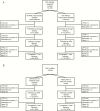Poor Obstetric and Infant Outcomes in Human Immunodeficiency Virus-Infected Pregnant Women With Tuberculosis in South Africa: The Tshepiso Study
- PMID: 29028970
- PMCID: PMC5849996
- DOI: 10.1093/cid/cix851
Poor Obstetric and Infant Outcomes in Human Immunodeficiency Virus-Infected Pregnant Women With Tuberculosis in South Africa: The Tshepiso Study
Abstract
Background: Before the wide availability of antiretroviral therapy (ART), tuberculosis and human immunodeficiency virus (HIV) disease among pregnant women resulted in poor maternal and neonatal outcomes, including high rates of mother-to-child transmission of both HIV and tuberculosis. We aimed to describe the impact of tuberculosis among HIV-infected mothers on obstetric and infant outcomes in a population with access to ART.
Methods: In this prospective cohort study, we followed up HIV-infected pregnant women with or without tuberculosis disease from January 2011 through January 2014 in Soweto, South Africa. Two controls were enrolled for each case patient, matched by enrollment time, maternal age, gestational age, and planned delivery clinic and followed up for 12 months after delivery.
Results: We recruited 80 case patients and 155 controls, resulting in 224 live-born infants. Infants of mothers with HIV infection and tuberculosis disease had a higher risk of low birth weight (20.8% vs 10.7%; P = .04), prolonged hospitalization at birth (51% vs 16%; P < .001), infant death (68 vs 7 deaths per 1000 births; P < .001), and tuberculosis disease (12% vs 0%; P < .001) despite appropriate maternal therapy and infant tuberculosis preventive therapy. HIV transmission was higher among these infants (4.1% vs 1.3%; P = .20), though this difference was not statistically significant. Obstetric outcomes in coinfected women were also poorer with higher risks of maternal hospitalization (25% vs 11%; P = .005) and preeclampsia (5.5% vs 0.7%; P = .03).
Conclusions: Tuberculosis in HIV coinfected pregnant women remains a significant threat to the health of both mothers and infants. Improving tuberculosis prevention and early diagnosis among pregnant women is critical.
© The Author 2017. Published by Oxford University Press for the Infectious Diseases Society of America. All rights reserved. For permissions, e-mail: journals.permissions@oup.com.
Figures
References
-
- World Health Organization. Tuberculosis fact sheet: tuberculosis in women Available at: http://www.who.int/tb/publications/tb_women_factsheet_251013.pdf. Accessed 15 October 2017.
-
- Sugarman J, Colvin C, Moran AC, Oxlade O. Tuberculosis in pregnancy: an estimate of the global burden of disease. Lancet Glob Health 2014; 2:e710–6. - PubMed
Publication types
MeSH terms
Substances
Grants and funding
LinkOut - more resources
Full Text Sources
Other Literature Sources
Medical


